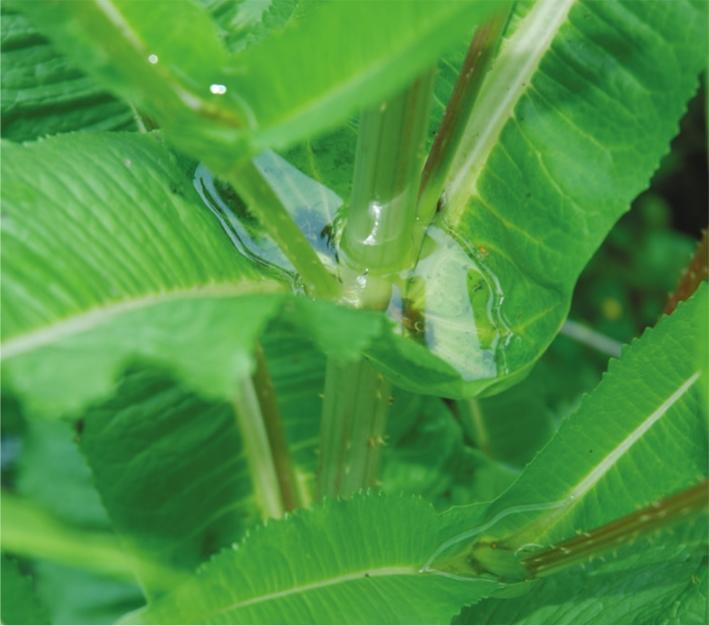Teasel is a stunning plant, tall and stately but also very beautiful if observed in detail when flowering. Its medicinal uses have long been appreciated in China, but are only recently being rediscovered by western herbalists.
Teasel helps with joint and tendon injuries, muscle pain and inflammation, chronic arthritis and lower back weakness. It is now being used for Lyme disease, ME and fibromyalgia.
Dipsacaceae Teasel family
Description: A tall biennial, up to 3m, with prickly rigid stems; small pale purple flowers in large conical flowerheads, opening from the middle; large and prickly basal leaves.
Habitat: Grassland, hedgerows, waste land and by motorways.
Distribution: Common in England and southern Wales, less frequent in Scotland and Ireland. Introduced to North America.
Related species: Fuller’s teasel (D. sativus) is grown for commercial use in the west country; Japanese teasel (D. japonicus) is used in Traditional Chinese Medicine.
Parts used: Root, flowers used as an essence.

Teasel folklore has long referred to the way it collects rainwater in the cups where the leaves surround the stem, known from ancient times as the bath of Venus. This teasel water was said to be good for warts but particularly beneficial as an eyewash and as a wash for beautiful skin. We update this healing potential of teasel water with a home-made flower essence.
Teasel’s famed commercial application is the use made of the dead flowerheads of the closely related fuller’s teasel (D. sativus) in ‘teasing up’ the nap on wool. is the Anglo-Saxon term for fulling or cleaning cloth. Common names for teasel like card weed, barber’s brush, brushes and gypsy’s comb reflect this formerly important economic activity.
Fuller’s teasel, with its hooked spines, was found to be uniquely effective both in manual and later in machine applications to raise the nap on fresh-made wool without breaking the cloth.
Use teasel for…
In Traditional Chinese Medicine, teasel root ‘tonifies the liver and kidneys’ and works on painful lower backs and knees, weak legs, cartilage and joints. It is also held to promote circulation and reduce inflammation. American herbalists William LeSassier and Matthew Wood have built on these uses and found in practice that the teasel (introduced from Europe) is, in Wood’s words, ‘invaluable’ for joint injury and chronic inflammation of the muscles. It is indicated for fibromyalgia, chronic arthritis, and Lyme disease.

The acute infection of Lyme disease, as explained in an excellent monograph by herbalist Stephen Harrod Buhner (which any Lyme sufferer should buy), involves these same issues of joint pain, blood circulation and tonifying of cartilage. Buhner finds results of using teasel root tincture for Lyme in the US are promising, though inconsistent in different regions.
Teasel flower essence has been found not only to bring relief in Lyme disease but also fibromyalgia, chronic fatigue and lupus. Treatment for these complex conditions should be in consultation with a herbalist and your doctor.
Because teasel root has to be dug in the first year when the plant is harder to identify, and as using the root kills the plant, we prefer a recipe for a flower essence.

Lyme disease
Lyme disease, or Lyme borreliosis, is on the increase in the British Isles and Europe.
The condition was first named in 1975 after a town in the US state of Connecticut, where there was an outbreak of ‘juvenile arthritis’. In 1982 the source was found to be a spirochaete carried by ticks on deer.
Borrelia, the spirochete that causes the disease, is an unusually complex bacterium whose closest relative is the spirochaete that causes syphilis.
The ticks that are the main carriers of Borrelia are very small, and you may not even be aware you have been bitten. The classic bull’s-eye rash, which spreads outwards from the bite, is diagnostic of Borrelia infection, but only occurs in about a third of cases.
Lyme disease is a complex illness, so if you suspect you have it, seek expert professional help as soon as possible.
Teasel essence
Make this essence on a sunny day, using the rainwater collected for you by the teasel plant. Bend the plant over to pour some of the water from the leaf cups into a jug, then choose a flowerhead and bend it over into the jug so that it is immersed in the water for a minute or two. Alternatively, you can hold the flowerhead over a bowl and pour the rainwater from the jug over the blossoms into the bowl. If there is any debris in the water, filter it through a piece of muslin or a tea strainer as you pour it into a clean container to take home with you.
Measure the water and add an equal amount of brandy to preserve it. Bottle in a clean blue glass bottle, and label it.
To use, put three drops of this essence in a 30ml dropper bottle filled with brandy. Add 20 drops to bathwater, or use as directed below.
Dose: Put three drops in a glass or bottle of water and drink during the day. Or put three drops into a small dropper bottle filled with half brandy and half water, and take by dropping a few drops directly under your tongue several times a day.